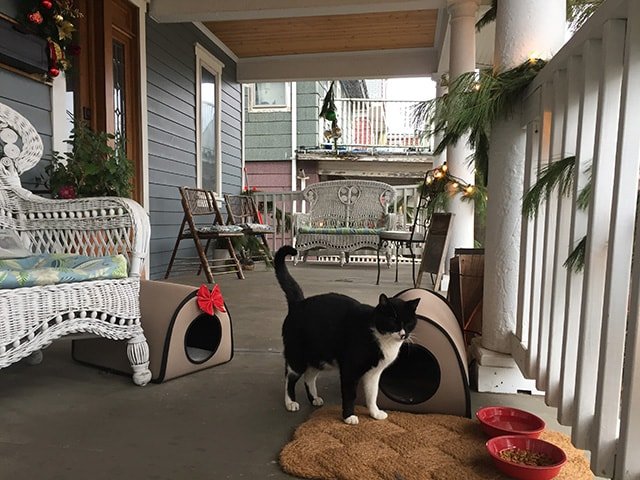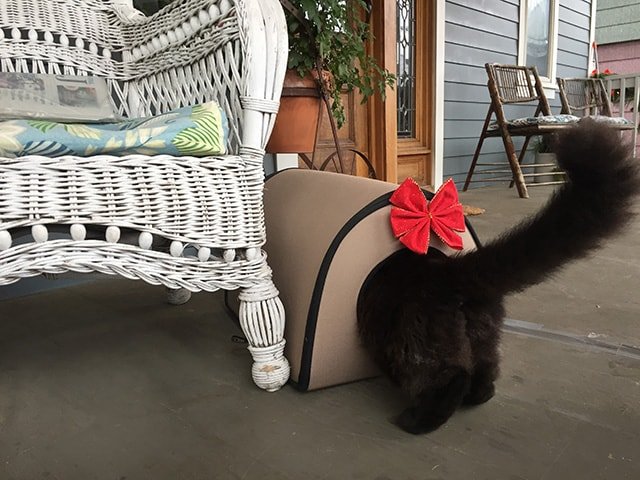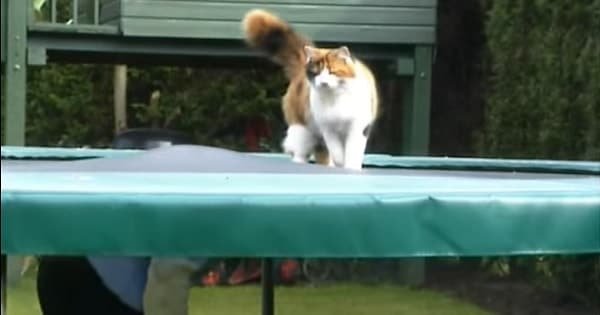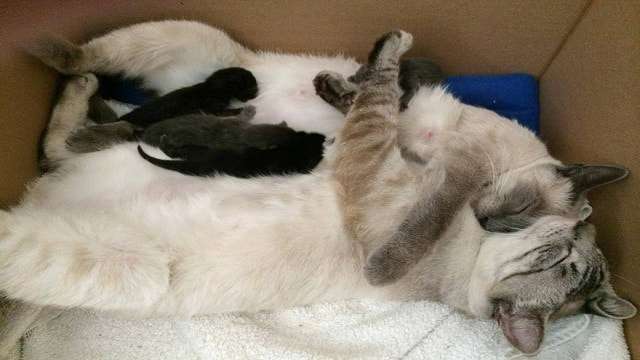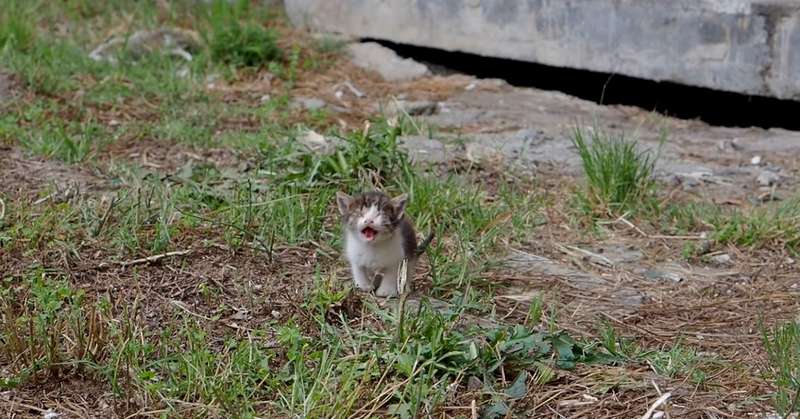NEW YORK: There are literally tens of thousands of stray and feral cats—also known as “community cats”—living in NYC. And with the chilly weather here now for the season, some cat lovers are working to create outdoor shelters for the animals. Paula DiGioia, who is a graphic designer who lives in the Rockaways with her husband, hosts a number of stray and feral felines around her home—and she’s just added luxury housing with heated kitty pods.
The Gothamist asked DiGioia about being a mom to the outdoor cats in her neighborhood, and advice for those who want to get involved to help their own neighbor kitties.
How many feral cats visit you?
“Six cats—Biff Howard, Obama, Fluffy, Van Gogh, One Eyed Willy and Blondie. The names are literal representations of how they look. Obama’s black and white, Van Gogh has one ear, One Eyed Willie has one eye and Blondie is blonde. Biff Howard is a charismatic bully inspired by Biff from Back To The Future.”
Out of my six, three are feral, three are strays. The difference between a stray and a feral is the extent to which they are socialized to humans. Strays are mostly friendly towards people; they may put their tail up when they see you, meaning they’re confident in their surroundings and happy. They’re vocal (unlike ferals) and you can often pet them! A feral will shy away when they see you, keeping a safe distance. Ferals have not had human interaction within the first 12 weeks of their life. (A good resource on socialization here. And a good site detailing about stray vs feral here“.
What’s the usual set-up for the feral kitties?
“The cats get fed every morning around 7:30 a.m. Some are waiting at the kitchen back door. It’s all glass so they stare inside. It’s impressive. Like clockwork every morning they wait. Then I go to the front door and do the same for others waiting there. Maybe it’s because I’m Italian, I can’t bare to see the cats waiting, hungry outside, so I do it first thing, even before I get dressed and put on a pot of coffee”.
“Mostly I feed them grain-free dry food, but in the winter I like to give them wet food occasionally as a special treat. I also leave water outside, it’s very important to provide water for strays/ferals as well as food”.
“Only if I see a cat waiting for me in the evening do I put out a little dinner. One feeding a day is adequate for ferals/strays. Usually, they have a secondary food source, for example, an occasional bird or mouse, or food coming from another cat caretaker. My neighbors also leave food out here and there—it’s helpful to have others involved with caring for the cats. In my case, it’s a community effort on my block in Rockaway”.
Is this the first year that you have added heated units? How has it gone so far?
“Yes, this is my first year with heated cat shelters. When I realized this was available, I immediately knew I wanted this for my strays. Call me a spoiler—I don’t care! Winters are just colder here than on the mainland. I wanted my cats to be comfortable this winter but more importantly, stay healthy”.
“Obama and Biff Howard live on my porch and sleep in the heated houses. I didn’t have to coax them, they just decided to go in when the weather got cold! The bottoms of the cat houses have plush heated mats. Very cozy! I leave the houses plugged in 24/7 but I’ve been thinking about hooking them up to a timer that will turn on when the temperature hits a specified degree”.
“Ideally, by next year I would like to have heated homes for all six, but finding the right location with access to electricity is difficult especially for the ferals who keep a safe distance. Oh and the raccoons may want to take over the heated houses too! So many logistics. Currently, the others sleep on my neighbor’s property—in his old shed and under the porch”.
“I had the idea for the shelters because a few of the houses on my block have sold and are now under construction. The refurbishment of these beautiful old Rockaway houses is great for our community but not so much for our cats. The strays are losing shelter when an old bungalow starts construction or a dilapidated garage is torn down”.
Do you have some tips for those who want to help out feral kitties in the neighborhood?
“If you’re interested in helping the ferals and stray cats in your neighborhood the first step is to take a TNR (Trap Neuter Release) class. I took mine with Animal Alliance NYC. It’s free and held in many locations around the city. After taking the class you receive certification and benefits from the ASPCA—discounted fees for neuter/spay; you can apply for free cat food; you can sign up for free transport on trapping days, and you can meet a network of cat lovers to help as you begin trapping and caring for ferals. It’s very important that the cats you are feeding are first neutered/spayed.
The goal of TNR is to reduce the feral cat population, feeding cats that are not fixed is doing the opposite. Each cat that is neutered/spayed by the ASPCA, and has their left ear cut, it’s called an ear tip. This is how you can tell if the cat you want to care for has been fixed already and received a rabies vaccine. Once you know your cat(s) have been neutered/spayed you can feed and start sheltering worry-free”.
“Heated shelters are a luxury, I want to make that clear! A regular outdoor cat shelter is totally acceptable. There are DIY instructions for building your own or you can buy one. Whether you use a heated kitty house or a regular one, cat shelters are instrumental to the survival of street cats”.
“Side note: The TNR class I took at the library in Far Rockaway was an intense experience, jam-packed with passionate cat people. Some were boasting about how large their colonies were; some were overly eager to share their unorthodox trapping techniques which the instructors frowned upon. One man was freaking out, telling everyone about the “Broad Channel cat poisoning incident” Having said that, I did learn a lot and it was worth attending”.
A question for those with no outdoor space – just how many cats is too many to have in an apartment?
“Ha! Well… that’s a funny question. I always thought four was at “crazy cat lady” level but now I have four in my house, so can I plead the 5th”?
“Okay, here’s what I really think – there are two factors to consider when expanding your cat family. One, the size of your apartment and two, the personality of your resident cat. Regarding apartment size, for a two bedroom, I would say three cats max. A one bedroom, two cats. A studio, one cat or two sibling cats that have never been separated. The short of it, one cat per room”.
“Your resident cat’s personality should be a major factor in your decision to get another cat or multiple cats. Some cats don’t want to share space regardless of the size of his/her territory (ie your apartment). The general rule when getting another cat is to get a younger cat of the opposite sex. They will get along best most likely. The older your cat is, the less likely it will be willing to share its home”.
“Cats are extremely territorial, too many cats in a small space is a bad idea. A great way to see if your cat is interested in a companion cat is to foster—fostering saves lives! Bushwick Street Cats and North Brooklyn Cats are two rescue groups I know are often looking for foster families”.


